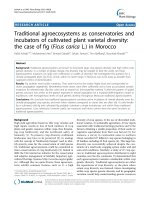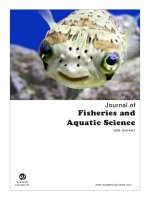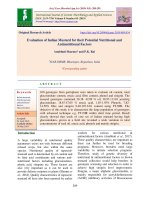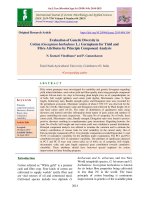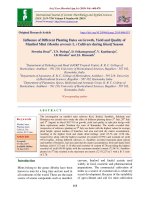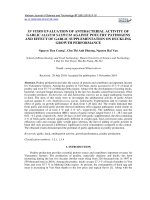Microbial and sensory evaluation of dried fig (F. carica L.) cultivars bellary and Poona
Bạn đang xem bản rút gọn của tài liệu. Xem và tải ngay bản đầy đủ của tài liệu tại đây (581.95 KB, 11 trang )
Int.J.Curr.Microbiol.App.Sci (2019) 8(5): 2493-2503
International Journal of Current Microbiology and Applied Sciences
ISSN: 2319-7706 Volume 8 Number 05 (2019)
Journal homepage:
Original Research Article
/>
Microbial and Sensory Evaluation of Dried Fig (F. carica L.)
Cultivars Bellary and Poona
T.S. Manjunath1*, P. Babu2, A.N. Bagali3 and K.S. Jyadati4
1
Department of Horticulture, 3Department of Horticulture, 4Department of Food Science and
Nutrition, College of Agriculture, Dharwad, University of Agricultural Sciences,
Dharwad, Karnataka, India
2
Department of Horticulture, College of Agriculture, Hanumanamatti, University of
Agricultural Sciences, Dharwad, Karnataka, India
*Corresponding author
ABSTRACT
Keywords
Sensory evaluation,
Dried fig, Quality
attribute
Article Info
Accepted:
26 April 2019
Available Online:
10 May 2019
Fresh fruits of two fig cultivars viz. Bellary and Poona subjected various osmotic pretreatments and tray-dried. Dried figs were further assessed to surface microbial population
to study the quality of dried product and evaluated for sensory qualities to understand the
influence of osmotic pre-treatments on sensory preference for the dried product. Off the fig
cultivars, statistically minimum surface count of bacteria (3.64 ×105 cfu/g), yeast (1.00 ×
103 cfu/g) and mould (0.97 103 cfu/g) population and maximum organoleptic scores for
appearance (7.07), aroma and flavour (7.14), taste (7.13), texture (7.27) and overall
acceptability (7.24) was recorded with dried Bellary figs. Among different osmotic pretreatments, fig fruits treated with 50⁰ Brix honey for 12 hours registered low bacterial
(0.50 × 105 cfu/g), yeast (0.53 × 103 cfu/g) and mould population (2.45 × 10 3 cfu/g) and
greater organoleptic scores for appearance (7.07), aroma and flavour (7.59), taste (7.58),
texture (7.79) and overall acceptability (7.67).
Introduction
Fig (Ficus carica L.) is one of the commercial
fruit crops grown in the arid and semi-arid
region of the Karnataka. In recent years, the
area under fig is gradually increasing,
resulting in increased production (Ganapat,
2012). Since it is a season bound crop,
increased production has led to seasonal glut
in the market fetching uneconomic prices to
farmers. Fig fruits being highly perishable
need to be consumed either fresh or processed
products. In the absence of commercially
available and economically viable technology
for processing, fig fruits are now being
disposed of only through fresh market. This
has caused considerable reduction in the price
of fresh fruits. Only a little attention has been
given to develop the processing technology
for fig. Based on the technology available for
2493
Int.J.Curr.Microbiol.App.Sci (2019) 8(5): 2493-2503
other fruits, few products such as dried fig, fig
burfi, syrup and wine has been tried. The
post- harvest losses of fresh fig fruits are a
major concern, as fruits are very delicate and
hence easily damaged during harvesting,
handling, and transportation. Further, as fruits
have a very thin and delicate skin, the postharvest physiological losses are higher.
The delicate structure of fruit has become an
impediment for long distance transport.
Hence, nearly 30 per cent of the crop is lost
due to improper handling, transportation and
storage condition (Madan and Ullasa, 1993).
Therefore, processing of fig fruits in to value
added products avoids market gut and
safeguards the prices and dried figs are
becoming increasingly popular creating
market demand. Taking all these factors in to
account, adopting osmotic dehydration
technique in combination with tray- drying
method an effort was made in the present
investigation to get good quality dehydrated
product through sensory and microbial
assessment.
Materials and Methods
The present investigation “Microbial and
sensory evaluation of dried figs of cultivars
Bellary and Poona” was carried out in the
Department of Horticulture, College of
Agriculture, Vijayapura, University of
Agricultural Sciences, Dharwad, Karnataka
during the year 2016-2017. Fruits of fig
cultivar Poona were procured from Indian
Institute of Horticulture Research (IIHR),
Bengaluru and cultivar Bellary were brought
from farmers field at Serigeri village, Bellary
District, Karnataka. Fig fruits of uniform size,
shape and maturity were selected and
carefully packed in corrugated fibre boxes
(CFB) having provision for ventilation with
paper straw as cushioning material, brought
for conducting experiment.
Pre-treatments and tray- drying
Fig fruits of cv. Poona and Bellary having
uniform colour, size and shape selected and
the diseased, bruised, immature, small sized
and damaged ones discarded. Stalk of the
fruits cut with knife and washed in clean
potable water to remove dust and residues of
chemicals present on the fruit skin. Before
drying, blanching of fruits done to inactivate
the enzyme and
prevent
microbial
contamination in subsequent operations. The
cleaned fruits were subjected to hot water
treatment at 90oC for 4 minute, then cooled to
room temperature and dipped in 0.2 per cent
potassium metabisulphite (KMS) solution for
5 minute followed by 0.25 per cent citric acid
for 4 minute and then drained (Rajendra,
2005) to keep the fruits ready for pretreatments.
After blanching and treatment with chemical
preservative and antioxidant, Poona and
Bellary figs (2 kg each) pre-treated (dipped)
with sucrose, honey, date and invert sugar
syrup at 50 0Brix for different duration to
study the influence of pre-treatments on
quality of dried figs. For drying, pre-treated
figs spread uniformly on the trays in a single
layer. The loaded trays placed in a tray-dryer
and then dehydrated. During the process of
drying, the temperature 55±4o C maintained
and dried for 46–52 hours to the moisture
level of 18–20 %, as per the protocol given by
Thonta and Patil (1988). Partially dried fruits,
when about 50-60 % moisture removed, taken
out and pressed carefully. After drying, the
samples packed in poly pouch and kept
hermetically sealed under ambient conditions.
Organoleptic evaluation of dried figs
Organoleptic evaluation of dried figs was
carried out by a panel of 10 semi-trained
judges consisting of teachers, staff and postgraduate students. The organoleptic characters
2494
Int.J.Curr.Microbiol.App.Sci (2019) 8(5): 2493-2503
like appearance, aroma and flavour, texture,
taste and overall acceptability of dried fig
fruits were evaluated based on nine-point
hedonic rating scale.
Dried figs of both the cultivars subjected to
microbial analysis conducted by dilution plate
technique (Shank et al., 1975).
pre-treatment also found non-significant.
However, lower values for bacterial counts
were recorded in honey (2.33 No × 105 cfu /g)
pre - treated Bellary fig for 12 hours, which
was on par with honey (2.57 No × 105 cfu /g)
pre - treated Poona figs for 12 hours. Greater
level of bacterial count was observed in
untreated Poona fig (4.62 No × 105 cfu /g),
which was on par with untreated Bellary fig
(4.59 No × 105 cfu /g).
Statistical analysis
Yeast count
The data on organoleptic characters and
microbial population recorded in the
experiment subjected to factorial completely
randomised design (FCRD). Interpretation of
data carried in accordance with Panse and
Sukhatme (1985). The level of significance
used in „F‟ test and „T‟ test was p = 0.05 (at 5
%). A critical difference (CD) was determined
whenever „F‟ test was significant.
The differences due to pre-treatments were
significant with respect to yeast count. The
minimum value for yeast count was recorded
in honey (0.50 No × 103 cfu /g) pre - treated
figs for 12 hours and maximum yeast count
was registered in untreated sample (1.51 No ×
103 cfu/g). Whereas, the differences due to
cultivars with respect to yeast count was nonsignificant. The highest value for yeast count
was recorded in cv. Poona (1.06 No × 103
cfu/g) compared to cv. Bellary (1No × 103
cfu/g). The interaction effect between cultivar
and pre - treatments also found nonsignificant. Most yeast count was observed in
untreated Poona fig (1.56 No × 103cfu/g),
which was on par with untreated Bellary fig
(1.46 No × 103 cfu/g). Whereas, less of yeast
count was recorded in date syrup (0.48 No ×
103cfu/g) pre - treated Poona fig for 12 hours,
which was on par with in date syrup (0.52 No
× 103cfu/g) pre - treated Poona fig for 12
hours.
Microbial analysis
Results and Discussion
Surface microbial population of dried figs
The data furnished in table 1 shows the
bacterial, yeast and mould count of dried figs
as influenced by pre-treatments, cultivars and
their interaction effects.
Bacterial count
The results indicated that only pre-treatments
had significant effect on bacterial count. The
minimum bacterial count was observed in
honey (2.45 No × 105 cfu/g) pre - treated figs
for 12 hours, while, the bacterial count was
maximum in untreated sample (4.61 No × 105
cfu/g). Non-significant differences registered
between cultivars with respect to bacterial
count. The highest value for bacterial count
was recorded in cv. Poona (3.75 No × 105
cfu/g) compared to cv. Bellary (3.64 No × 105
cfu/g). Interaction effect between cultivar and
Mould count
Significant difference due to pre-treatments
observed with respect to mould count. The
minimum value for mould count was recorded
honey (0.53 No × 103 cfu/g) pre - treated figs
for 12 hours, which was on par with date
syrup (0.59 No × 103 cfu/g) pre - treated figs
for 12 hours, whereas, maximum mould count
was in untreated sample (1.57 No × 103
2495
Int.J.Curr.Microbiol.App.Sci (2019) 8(5): 2493-2503
cfu/g). However, the data with non-significant
differences registered between cultivars with
respect to mould count. The highest value for
mould count was observed in cv. Poona (1.02
No × 103cfu/g) compared to cv. Bellary (0.97
No × 103 cfu/g). The differences due to
interaction between cultivars and pretreatments were also non-significant. The
mould count observed maximum in untreated
Poona fig (1.60 No × 103 cfu/g), which was
on par with untreated Bellary fig (1.53 No ×
103 cfu/g). It was minimum in date syrup
(0.41 No × 103 cfu/g) pre - treated Bellary fig
for 12 hours, which was on par with in honey
(0.44 No × 103 cfu/g) pre - treated Poona fig
for 12 hours in case of cultivar Poona.
Organoleptic characteristics of dried figs
The organoleptic evaluation of dried figs
prepared from cultivar Poona (Fig. 1) and
cultivar Bellary (Fig. 2) using different pretreatments, done to assess the consumer
preference by a panel of semi-trained judges
for appearance, aroma and flavour, taste,
texture and overall acceptability. The data on
appearance, aroma and flavour, taste, texture
and overall acceptability of dried figs as
influenced by cultivars, pre - treatments and
their interaction effects furnished in table 2.
Appearance
The data revealed significant differences due
to pre - treatments with respect to appearance.
Highest score for appearance found in invert
sugar (7.74) pre - treated figs for 24 hours,
which was on par with date syrup (7.60) pre treated figs for 12 hours and lowest score for
appearance found in untreated sample (5.99).
Whereas, the difference due to cultivars were
found non – significant and highest score for
appearance was recorded in cv. Bellary (7.07)
compared to cv. Poona (6.82) and also, the
interaction effect between cultivar (C) and
treatments (T) found non-significant. Score
for appearance found maximum in Bellary fig
dipped in invert sugar (7.86) for 12 hours,
which was on par with Bellary fig pre-treated
with sucrose (7.70) for 24 hours and
minimum in untreated Poona fig (5.99).
Aroma and flavour
The data indicated that, cultivars and pretreatments effect differed significantly.
Considering the score for pre-treatments,
irrespective of cultivars, significantly highest
score for aroma and flavour was recorded in
honey (7.59) pre – treated figs for 12 hours,
while, lowest score was recorded in untreated
sample (5.71). However, the organoleptic
score for aroma and flavour with respect to
cultivars found to be non-significant. The
highest score recorded in cv. Bellary (7.14)
compared to cv. Poona (6.86). The results for
interaction effect due to cultivars and pretreatments also found non-significant and
highest score recorded in Bellary fig dipped in
honey (7.76) dipped for 12 hours and
minimum in untreated Poona fig (5.38).
Taste
The results revealed that the pre-treatments
registered significant effect on taste. Highest
score due to pre-treatments, irrespective of
cultivars was found in honey (7.58) pre treated figs for 12 hours, which was on par
with invert sugar (7.57) pre - treated samples
for 24 hours, whereas, lowest score for taste
was found in untreated samples (6.14). The
sensory scores for taste due to cultivars
however found to be non-significant, the
cultivar Bellary had maximum score (7.13)
compared to cultivar Poona (6.95). The
interaction effect between cultivars and
treatments with respect to taste also found
non-significant, though Bellary fig dipped in
honey (7.70) for 12 hours had maximum
score while, untreated Bellary fig (6.13) had
minimum score.
2496
Int.J.Curr.Microbiol.App.Sci (2019) 8(5): 2493-2503
Table.1 Effect of pre-treatments and cultivars on bacterial count, yeast count and mould count of
dried fig fruits
F1 - Pre-treatments
Bacterial count
Yeasts count
5
3
Moulds count
(No × 10 cfu /g)
(No × 10 cfu/g)
(No × 103 Cfu/g)
T1
4.61
1.51
1.57
T2
4.10
1.31
1.18
T3
2.45
0.50
0.53
T4
3.31
0.60
0.59
T5
4.04
1.25
1.12
Mean
3.70
1.03
0.99
S. Em.±
0.18
0.11
0.08
CD at 5 %
0.56
0.30
0.25
C1
3.75
1.06
1.02
C2
3.64
1.00
0.97
Mean
3.70
1.03
1.00
S. Em.±
0.11
0.07
0.05
CD at 5 %
NS
NS
NS
T1C1
4.62
1.56
1.60
T1C2
4.59
1.46
1.53
T2C1
4.30
1.34
1.16
T2C2
3.89
1.29
1.20
T3C1
2.57
0.64
0.44
T3C2
2.33
0.55
0.62
T4C1
3.65
0.48
0.76
T4C2
2.97
0.52
0.41
T5C1
3.89
1.30
1.14
T5C2
4.18
1.20
1.11
Mean
4.10
1.44
1.41
S. Em.±
0.26
0.15
0.12
CD at 5 %
NS
NS
NS
F2 - Cultivars
Treatments interaction
Note: NS – Non-significant
T1- Control (Untreated)
T2- Fruits dipped in 50o Brix of Sucrose for 24 hours
T3- Fruits dipped in 50o Brix of Honey for 12 hours
T4- Fruits dipped in 50o Brix of Date syrup for 12 hours
T5- Fruits dipped in 50o Brix of Invert sugar (50% glucose + 50% fructose) for 24 hours
C1- Poona
C2- Bellary
2497
Int.J.Curr.Microbiol.App.Sci (2019) 8(5): 2493-2503
Table.2 Effect of pre-treatments and cultivars on sensory characteristics of dried fig fruits
F1 – Pre-treatments
Appearance
Aroma and
Taste
Texture
flavour
Overall
acceptability
T1
5.99
5.71
6.14
6.09
5.92
T2
7.60
7.21
7.00
7.25
7.55
T3
7.28
7.59
7.58
7.79
7.67
T4
6.14
7.27
6.98
7.56
6.76
T5
7.74
7.25
7.57
7.35
7.65
Mean
6.95
7.00
7.05
7.21
7.11
S. Em.±
0.13
0.13
0.46
0.08
0.08
CD at 5 %
0.37
0.40
1.37
0.23
0.25
C1
6.82
6.86
6.95
7.13
6.97
C2
7.07
7.14
7.13
7.27
7.24
Mean
6.95
7.00
7.04
7.20
7.11
S. Em.±
0.08
0.08
0.29
0.05
0.05
CD at 5 %
NS
NS
NS
NS
0.15
T1C1
5.99
5.38
6.15
5.90
5.72
T1C2
6.25
6.04
6.13
6.28
6.11
T2C1
7.50
7.17
6.81
7.09
7.50
T2C2
7.70
7.24
7.17
7.40
7.60
T3C1
7.19
7.42
7.52
7.92
7.55
T3C2
7.37
7.76
7.61
7.65
7.78
T4C1
6.10
7.19
6.89
7.52
6.52
T4C2
6.18
7.35
7.06
7.60
7.00
T5C1
7.63
7.18
7.45
7.24
7.60
T5C2
7.86
7.31
7.70
7.46
7.70
Mean
6.95
7.00
7.08
7.21
7.11
S. Em.±
0.18
0.18
0.66
0.12
0.11
CD at 5 %
NS
NS
NS
NS
NS
F2 – Cultivars
Treatments interaction
Note: NS - Non significant
2498
Int.J.Curr.Microbiol.App.Sci (2019) 8(5): 2493-2503
Fig.1 Tray-dried Poona fig fruits
Untreated (control)
Sucrose (50º Brix) pre- treatment
Honey (50º Brix) pre-treatment
for 24 hours
for 12 hours
Date syrup (50º Brix) pre- treatment
Invert sugar (50º Brix) pre-treatment
for 24 hours
for 12 hours
2499
Int.J.Curr.Microbiol.App.Sci (2019) 8(5): 2493-2503
Fig.2 Tray-dried bellary fig fruits
Untreated (control)
Honey (50º Brix) pre-treatment
Sucrose (50º Brix) pre- treatment
for 24 hours
for 12 hours
Date syrup (50º Brix) pre- treatment
Invert sugar (50º Brix) pre-treatment
for 24 hours
for 12 hours
2500
Int.J.Curr.Microbiol.App.Sci (2019) 8(5): 2493-2503
Texture
Surface microbial population of dried figs
The data presented in the table depicted that
the pre-treatments effects were differed
significantly. Irrespective of cultivars, the
highest score for texture found in honey
(7.79) dipped figs for 12 hours, which was on
par with date syrup (7.56) dipped samples for
12 hours, while untreated samples (6.09)
recorded the lowest score for texture. On the
other hand, there was no significant effect
found due to cultivars. However, maximum
score for texture recorded in cv. Bellary
(7.27) and minimum in cv. Poona (7.13).
Interaction effect between cultivars and pretreatments for the texture of dried figs were
also found non-significant; figs pre – treated
(7.92) with honey for 12 hours had maximum
score (7.70) and minimum score for texture
recorded in untreated Poona fig (5.90).
The behaviour of the different groups of
microorganisms immediately after processing
was quite different and depends upon the type
of pre-treatments used before dehydration.
Thus, the trend of decreasing the total counts
of bacteria, yeast and moulds well correlated
with the type of osmotic solution used in the
pre-treatment before dehydration (Manal and
Gend, 2014).
Overall acceptability
The results indicated that the pre-treatments
and cultivars effects differed significantly.
Considering pre-treatment scores, irrespective
of cultivars, noticed that significantly higher
score in honey (7.67) pre - treated figs for 12
hours, which was on par with invert sugar
(7.65) pre - treated samples for 24 hours, and
least score for overall acceptability found in
untreated fig samples (5.92). Score
for
overall acceptability for cultivars, irrespective
of pre-treatments, also found to be significant.
Highest score for overall acceptability
registered in cv. Bellary (7.24) compared to
cv. Poona (6.97). Notwithstanding, nonsignificant differences were registered due to
interaction effect between cultivars and pretreatments, Bellary fig (7.78) pre - treated in
honey for 12 hours had maximum score,
which was on par with invert sugar pretreated (7.70) Bellary fig and untreated Poona
fig (5.72) had minimum score for overall
acceptability.
Among the various pre - treatments tried,
least microbial population recorded in honey
pre – treated dried figs for 12 hours (Table 1).
This may be due to anti-microbial activity of
honey, results in inhibition of microbial
growth. While, highest value for microbial
population was observed in untreated
samples. This might be due to nonpreservative action in control samples, which
resulted in more microbial population.
However, there were no significant
differences between the cultivars for the
presence of microbes in dried figs though it
was more in cv. Poona. This might be due to
high moisture content in Poona figs compared
to that of Bellary figs. Sowjanya and Rao
(2004) also opined that moisture plays
important role in growth of microbial
organisms on dried products. Naikwadi et al.,
(2010) reported similar results in dried fig
fruit. These results show that the immersion
of figs in different osmotic solutions before
dehydration was efficient in reducing the total
counts of bacteria, yeasts and moulds.
Organoleptic characteristics of dried figs
The merits of any consumable products
depend not only on its composition and
nutritive value, but also on sensory quality.
Evaluation of sensory quality of a product is
an important tool for deciding the consumer
acceptability. Appearance, aroma, flavour,
texture, taste and overall acceptability are the
2501
Int.J.Curr.Microbiol.App.Sci (2019) 8(5): 2493-2503
important sensory traits, which decide the
consumer acceptability of any product, in
general. Therefore, the sensory evaluation of
dehydrated fig fruits carried out by a panel of
judges consisting of semi-skilled persons /
staff of the campus.
Bellary (7.07, 7.14, 7.13, 7.27 and 7.24 for
appearance, aroma and flavour, taste, texture
and overall acceptability, respectively) to that
of cv. Poona (6.82, 6.86, 6.95, 7.13, and 6.97,
respectively). This might be attributed to
varietal characteristics of fruits.
In the present investigation, the results of
sensory evaluation of dehydrated fig fruits
presented in table 2 have clearly indicated that
all the pre-treatments helped to obtain
organoleptically acceptable dried fig.
Non-significantly highest score for interaction
effect among cultivars and pre-treatments for
appearance was (7.86) in invert sugar pretreated Bellary cultivar for 24 hours and
minimum in untreated Poona fig (5.99).
Highest score for aroma and flavour (7.76)
and overall acceptability (7.78) found in
Bellary fig pre-treated with honey for 12
hours and for taste (7.70) in Bellary fig pretreated with invert sugar for 24 hours while,
maximum score for texture (7.92) found in
Poona fig pre-treated with honey for 12 hours.
However, minimum sensory scores given to
untreated Poona figs (5.99, 5.38, 5.90, and
5.72), respectively for appearance, aroma and
flavour, texture and overall acceptability.
While, for taste (6.13), it was minimum in
untreated Bellary figs. Fruits and vegetables
flavour depends upon taste (balance between
sweetness and sourness or acidity, and low or
no astringency) and aroma (concentrations of
odour-active volatile compounds) (Kader,
2008). Although taste and aroma are well
integrated in their contribution to the overall
flavour, aroma is often considered to play a
dominant role in flavour (Goff and Klee,
2006).
Among the pre - treatments tried, the fig fruits
pre-treated with honey for 12 hours showed
the highest sensory scores for aroma and
flavour (7.59 %), taste (7.58 %), texture (7.79
%) and overall acceptability (7.67 %). This
might attributed to natural properties of honey
flavour, sugar content and sugar: acid ratio
influencing consumer acceptance for these
organoleptic parameters.
The consumer acceptability of dried fruit
directly related to their aroma and flavour and
texture (Abano and Sam-Amoah, 2010). The
moisture content in honey pre-treated samples
influenced texture of dried fig that will result
in softness of the product. This overall
preference for honey pre –treated dried figs
could attributed to the fact that sugar profiles
of honey, which results sweet in taste. The
organoleptic score for appearance (7.86) was
highest in invert sugar pre- treated figs for 24
hours and lowest in untreated samples (5.99)
irrespective of the cultivars. This might be
due to sugar crystallization on the surface of
dried figs (Naikwadi et al., 2010).
Conversely, the position of the control in the
hedonic rating scale indicates that pretreatments had tremendous influence on the
consumer acceptance of the dried products.
The scores for appearance, aroma and flavour,
taste, texture and overall acceptability showed
non-significant differences among cultivars.
Highest organoleptic scores obtained in cv.
From the above results it could be concluded
that better quality dried fig with good overall
acceptability can be obtained when Bellary
figs pre- treated with 50⁰ Brix with honey for
12 hours.
Acknowledgement
Authors are heartily thankful to the faculty of
the Department of Horticulture, College of
Agriculture,
Dharwad,
University
of
Agricultural Sciences, Dharwad and for
2502
Int.J.Curr.Microbiol.App.Sci (2019) 8(5): 2493-2503
providing all the facilities and support to
conduct the research program.
References
Abano, E. E., Sam-Amoah, L. K., Owusu, J.
and Engmann, F. N., 2010, Effects of
ascorbic acid, salt, lemon juice, and
honey on drying kinetics and sensory
characteristic of dried mango. J. Food
Sci. Technol. 5(1): 1 - 1.
Ganpat, D. D., 2012. The economic impact of
fig production on dry land farmers in
Pune district: with special reference to
Purandar Taluka. Ph.D. (Agri) Thesis,
Tilak Maharashtra Vidyapeeth, Pune,
India.
Madan, M. S. and Ullasa, B. A., 1993, Post
harvest losses in fruits. IV Ed.
Advances in Horticulture. Malhotra
Publishing House New Delhi, (1):
1795 - 1810.
Manala, E and Gend. 2014, Evaluation of
quality attributes of dehydrated figs
prepared by osmotic- drying process,
Egypt J. Agric. Res. 92(1): 337 – 347.
Naikwadi, P. M., Chavan, U. D., Pawar, V. D.
and Amarowicz, R., 2010 Studies on
dehydration of figs using different
sugar syrup treatments, J. Food. Sci.
Tech. 47(4): 442-445.
Panse, V. G. and Sukatme, P. V., 1985,
Statistical methods for Agricultural
workers, ICAR, New Delhi. 2: 152 155.
Sowjanya, P. and Rao, V. P., 2004, Studies on
quality of solar and tray dried figs.
M.Sc. (Home Science) Thesis,
Acharya Ranga Univ. Agric. Sci.,
Hyderabad (India).
Rajendra, K., 2005, Dehydration of fig fruits.
M. Sc. (Hort.) Thesis, Univ. Agric.
Sci., Dharwad.
Goff, S. A., and Klee. H. J., 2006, Plant
volatile compounds: sensory cues for
health and nutritional value. J. Food
Sci., 311, 815 - 819.
Kader, A. A., 2008, Flavour quality of fruits
and vegetables. J. Sci. Food Agric.,
88: 1863 - 1868.
Shank, C. R., Duguid, J. P., Marmion, B. P.
and Swain, R. H. A., 1975, Medical
Microbiology. The practice of medical
microbiology, Churst II Livingstone,
Edinburgh, London and New York.
pp. 306 - 310.
Thonta, G. T. and Patil, V. K., 1988, Studies
on drying of Fig fruits (Ficus carica
L.). Indian Food Packer. 42(4): 94 99.
How to cite this article:
Manjunath, T.S., P. Babu, A.N. Bagali and Jyadati, K.S 2019. Microbial and Sensory
Evaluation of Dried Fig (F. carica L.) Cultivars Bellary and Poona.
Int.J.Curr.Microbiol.App.Sci. 8(05): 2493-2503. doi: />
2503

